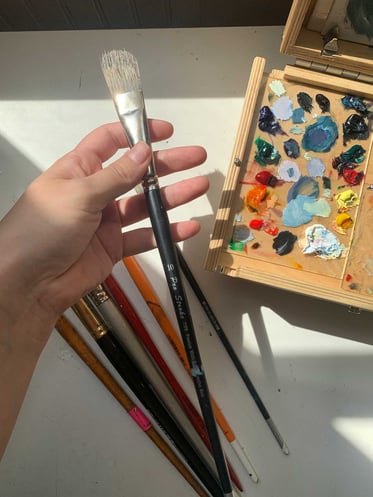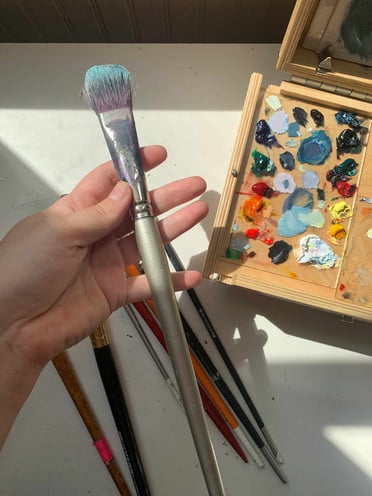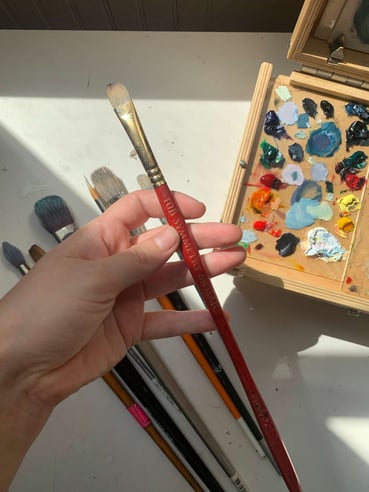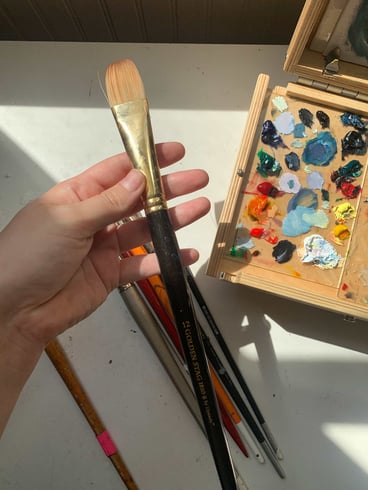In an artist’s world, a paintbrush is like a magic wand; it can yield great magic or tremendous tragedy... Maybe that’s an exaggeration coming from an artist, but an artist’s paintbrushes are incredibly important! When you choose the correct brush, you can allow that brush to do the work for you, letting it work its magic to help you create the masterpiece in your mind. The question now is how do you properly choose the right brush? Today, you’re in luck; below you will find a comprehensive guide on how to choose artist paint brushes and all the intricacies and varieties that come with it.
Shapes of Brushes
There are several different types of paint brushes, and more specifically, different shapes. You have round, square (bright), filbert, and script (line) brushes. A round brush will be circular at the base, and will usually come up to a point. Square brushes will have a square shape from one side, and when you turn it, it appears to be a skinny line. Filbert brushes are similar to square brushes, except instead of a flat line at the top, they are rounded off, like a dome. Finally, script, or line, brushes are long and thin. All of the different shapes also come in different sizes, from 20/0-30. This gives you even more versatility with each and every brush. Remember: the variety of brushstrokes is the spice of life and will add tremendous amounts of flavor to your work!
Brushes for Detail Work
Script and round paintbrushes are the best paint brush for small details. Round brushes come in a large variety of sizes, whereas script brushes come in small, extra small, and extra teeny tiny. Round brushes are my personal favorite because of their shape. They come to a fine point, but because the base is thicker, you can get a wide variety of shapes with a single stroke. I exclusively use this type of brush for tiger stripes, as there is such a wide variety of widths when it comes to the stripes. Script brushes are perfect for thin and delicate, swirly abstract lines, or for eyelashes, and tiny details like the sparkle in the eye.


Brushes for Edging
Square brushes are the absolute best if you’re going for a crisp straight line. Load up the top of your brush with just enough paint to stamp that perfectly straight line, which will match the length of the bristles on your brush. You won’t be disappointed! These brushes are also great for more geometric imagery and plane shifts. Remember to consider the size of the brush for the strokes you are looking to create. Don’t try using a size 12 square for a smaller shape, when you could use a size 4 with no trouble. This goes with all shapes of brushes!
Brushes for Blending
If you’re wondering what paint brush to use for blending soft edges, the absolute must-haves are the filbert and chip brushes. The flagged bristles in chip brush make it perfect for removing all traces of brushstrokes and leave you with a smooth, blended surface. Filberts are a great blending brush, as well, but are also very versatile. You can create soft blended edges with a filbert, but you can also create very beautiful dry-brushed textures and painterly brushstrokes.
Paint Choice vs. Bristle Type
With every brush size and shape, there is a natural bristle and synthetic bristle option. Natural bristle brushes are a better option when choosing for oil paint brushes. They are significantly softer, and will react to the oils in the paints better. When trying to choose acrylic paint brushes, synthetic brushes are excellent. The acrylic paint doesn't absorb into the synthetic bristles, making it easier to move acrylic paint onto the canvas. You can use synthetic brushes for oil painting as well, but beware that the paint thinners you will need to use for oil painting will take more of a toll on your brushes. Natural hair bristles are a higher quality and have a longer life expectancy. Whereas synthetic bristle brushes are less expensive, but won’t last as long. When purchasing either type of brush, it’s important to check the quality before buying. If you take the bristles between your thumb and index finger and tug lightly, you should not have any bristles coming out. If you see that the brush sheds several bristles, go for a higher-quality brush. You want to avoid getting bristles stuck in your paintings and get brushes that will last.


Size Does Matter…With Your Brushes
When painting, size does matter! I have seen it happen so many times; a large canvas piece being painted with a teeny tiny filbert the whole way through. **Shakes fists** Why!? Let your brush work for you! There is a reason there are so many variations in brush size. You want to use the size of brush that makes the most sense for that stroke. It’s not time-efficient or logical to try covering a large background area with a size 4 filbert! Use a size 12+ filbert or even better, a $2 chip brush. They are quite underrated, and an absolute staple. I would say it’s a great idea to have at least 3 different sizes of each shape on hand. They can vary in the bristle type, but it’s so helpful to have a good size variety.


How to Care for Your Brushes
Brush care varies with the different types of painting brushes. With synthetic brushes, you can use water and a bit of gentle soap to remove fresh wet paint from the bristles. For natural hair brushes, you will want to have a brush care routine. When you are regularly painting, every day or every other day, you can simply clean any excess paint off the bristles with a clean cotton rag, dip them in a clean conditioning brush dip, and leave them to rest until your next painting session. When I first started painting, I would wash my natural hair brushes after every session with Dawn soap, and my brushes would very quickly frizz up and fray, and I never understood why, until very recently. These natural hair brushes are sensitive and need to be conditioned with special brush oils. Using dish soap strip them of the oils and dries them up quickly. Even if you plan to leave your brushes for a long period of time, you still want to be sure to clean with a very mild brush soap, dip in a brush dip, reshape your brush, and lay them flat. You can also have your brushes standing with the bristles pointed up, so as to not ruin the shape of your brush. If you have natural hair brushes, it’s important to not overwash them. Keep them conditioned with a store-bought, or homemade brush dip. Synthetic brushes are, of course, easier to care for; any mild soap and water will do. Again, with your brushes, after they've been washed, be sure to reshape them and leave them either lying flat or standing up. Never put your brush head down in a brush holder or vase, as it will ruin the shape of your brushes.
The takeaway I hope you experience from this guide is to simply know your tools! Know what you need and what works best for you by testing and experimenting with lots of different brushes. There are so many amazing and unique tools and paintbrushes for art out there. Maybe you’ll discover that you despise cleaning brushes, and want to go full throttle with palette knives. As you spend time painting with your brushes, you will notice you gravitate towards certain ones, and may really only utilize about 5 brushes all together. This is totally fine! Once you understand the wide variety of tools, it will open your mind to new possibilities and hopefully some experimentation. Time to pick out and pick up those brushes. Happy painting, artists!
Now that you know the best brushes to use for painting, it’s time to learn how to use them! Check out 50 different ways to lay down paint.
